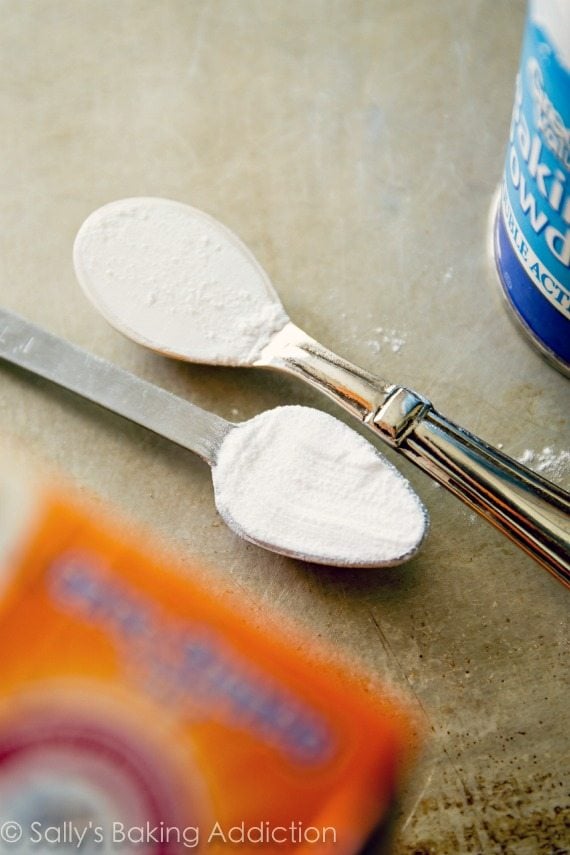Become a better baker by learning the real differences between baking powder and baking soda—in easy-to-understand language!
Today I’m discussing one of the most confusing subjects in the entire realm of baking. What is the difference between baking powder and baking soda? Are they the same? Can I sub one for the other without changing anything else?
If there is one thing that you take away from today’s lesson, let it be this: baking powder and baking soda are absolutely not the same.
As with baking soda, the purpose of baking powder is to create air bubbles that give your baked goods their light, airy texture. There are two types of baking powder: single action and double action. Single action baking powder creates the carbon dioxide bubbles upon contact with moisture, similar to baking soda.
:max_bytes(150000):strip_icc()/make-your-own-baking-powder-995820_color-a798837478cc483abcbcffe95bb22a93.png)
What is Baking Soda?
Aka bicarbonate of soda or sodium bicarbonate.
Let’s start with baking soda because it’s the most confusing. First, baking soda is a BASE. Do you remember the science experiment we all did in school? Mixing baking soda with vinegar and watching an eruption of bubbles? Usually we did this in some sort of model volcano contraption. I know you know. When you mix baking soda (BASE) with vinegar (ACID) you get a chemical reaction (an eruption of bubbles!). A product of this reaction is carbon dioxide.
The same exact reaction happens in our cookies, cakes, breads, etc. When a recipe calls for baking soda (BASE), it usually calls for some type of ACID like buttermilk, brown sugar, yogurt, lemon juice, vinegar, cream of tartar, molasses, applesauce, natural cocoa powder (not dutch process), or honey. You need this ACID in the recipe to react with the baking soda, which in turn creates carbon dioxide and allows your baked good to rise.
Baking soda is strong. In fact, it is about 3-4x stronger than baking powder. More baking soda in a recipe doesn’t necessarily mean more lift. You want to use *just enough* to react with the amount of acid in the recipe. Too much baking soda and not enough acid means there will be leftover baking soda in the recipe. You do not want that; it creates a metallic, soapy taste in your baked goods. Ick.
Good rule of thumb: I usually use around 1/4 teaspoon of baking soda per 1 cup of flour in a recipe.
Baking soda CAN leaven a baked good when exposed to heat. However, unless it is neutralized with an acid, your finished baked good will likely have a metallic aftertaste—like I mention above. Get it? Got it? Good.

What is Baking Powder?
Baking powder contains baking soda. It is a mixture of baking soda, cream of tartar (a dry acid), and sometimes cornstarch. These days, most baking powder sold is double acting. This means that the first leavening occurs when baking powder gets wet—like when you combine the dry and wet ingredients in the recipe. (This is why you cannot prepare some batters ahead of time to bake later—because the baking powder has already been activated.) The second leavening occurs when the baking powder is heated.
Double (first, second) acting.
Since baking powder already contains an acid to neutralize its baking soda, it is most often used when a recipe does not call for an additional acidic ingredient. Like my sugar cookies. However, this isn’t always the case. You can still use baking powder as the leavening agent in recipes calling for an acidic ingredient. Like my lemon blueberry cake. In my recipe development, I based my lemon cake recipe off of my vanilla cake recipe. I used buttermilk (acid) instead of regular milk for added moisture and a little tang and subbed a little brown sugar (acid) for granulated sugar—again, for added moisture. I was pleased with the rise and taste of the cake, so I did not experiment with using baking soda.
Good rule of thumb: I usually use around 1 teaspoon of baking powder per 1 cup of flour in a recipe.

What Do Baking Soda and Baking Powder Do? | Kenji’s Cooking Show
FAQ
How does baking powder affect cooking?
What is difference between baking soda and baking powder?
What happens if you don’t use baking powder?
What is the purpose of baking powder?
How does baking powder work?
Baking powder is used in baking to make cake batter and bread dough rise. The big advantage of baking powder over yeast is that it works instantly. Here’s how the chemical reaction in baking powder works. Baking powder contains baking soda (sodium bicarbonate) and a dry acid (cream of tartar or sodium aluminum sulfate).
Are powdered forms of superfoods good for you?
Powdered forms of superfoods are only good when it is not possible to achieve the same goals by eating natural foods. They are great as a complementary strategy but under no circumstances should they replace a healthy diet with natural foods.
Why is baking powder important?
Baking powder plays a crucial role in the texture, volume, and taste of baked goods. It helps in achieving the desired texture and fluffiness of cakes, muffins, cookies, and other pastries. Without baking powder, baked goods would be dense, heavy, and flat, lacking the lightness and airiness that makes them so delicious.
What is baking powder?
Baking powder is a chemical leavening agent that combines sodium bicarbonate ( baking soda) and an acid (or even two acids!) in one single dry, white powder. It’s sold in grocery stores and bulk food stores.
